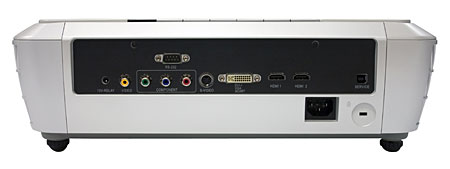Optoma HD8000 1080p DLP Projector Page 2
Gamma generally affects the brightness of the image in the mid-brightness region (it changes the input signal level vs. average picture level curve). But in the Optoma it also somewhat affected the black and peak white levels as well. The best black level I was able to get (0.008fL on my screen, with a peak contrast of 1,911:1), was comparable to the results I have seen from other respectable but not state-of-the-art DLP projectors. But the settings that produced this result (Iris on 12, Gamma -1, Contrast 38, Brightness 53) resulted in an image that was lacking in punch through the mid-brightness region—even though the peak white level was more than adequate.

I finally settled on a different setup with the iris at its midpoint (see "Settings"). This resulted in a peak contrast ratio and black level that were merely adequate compared to the best displays we've seen recently. Nevertheless, it produced a satisfying compromise for all types of scenes—dark, mid-bright, and bright, with a punchy image on everything but the dimmest scenes with low intra-scene contrast.
Some of those dark scenes looked a bit gray, and shadow detail was not exceptional, but over a wide range of material these shortcomings weren't overly distracting. The climactic scenes in Disturbia (Blu-ray), for example, take place in a dark crawl space/basement. While you can see enough to know what's going on, thanks to the light from a flashlight, as viewed on the HD8000 the entire sequence is a bit grayed-out, with mediocre shadow detail. But this is a sequence that will challenge most digital displays.
Transformers isn't a classically pretty film, and its "look" is often heavily processed, with exaggerated whites and blacks (the latter sometimes looking a little crushed even on the best displays) and stylized colors. But it's been given a superb HD DVD video transfer (spectacular sound, too). It has a lot of dark scenes, but most of them have bright highlights that clarify details. Apart from shadow detail that's only fair at best, this film does not look grayed out on the Optoma; in fact it looks extremely good given the projector's less than amazing black level and peak contrast.
When I moved up to brighter images, the Optoma found even more solid footing and provided impressive performance. A Knight's Tale is a peculiar film, but it would have worked if the filmmakers had had faith in the story and not tried to dress it up with the gimmick of a rock soundtrack. Its Blu-ray transfer was underappreciated when it was released, coming as it did in the very first, much criticized batch of Blu-ray discs. But while it has a few difficult dark scenes, most of it is brightly and beautifully photographed. And for the most part it looked outstanding on the Optoma—sharp, crisp, and dimensional, with clean, unexaggerated color.
While high-definition certainly looked good on the HD8000, the projector didn't skimp on good standard def DVDs, either. Kenneth Branaugh's Hamlet is a transfer we'd all have been raving about two years ago, but even without HD chops it was impressive on the Optoma. The bright scenes popped with good SD detail and bright colors, and even the dark scenes (few of which are truly challenging, it must be said) looked good.
Back to high-definition, Pirates of the Caribbean: The Curse of the Black Pearl is arguably the best-looking Blu-ray disc yet released. And it never looked less than good on the Optoma in its well-highlighted dark scenes, and often spectacular in its brighter ones. As I watched it on the last day of testing, and it was difficult to tear myself away from the experience to finish the review!
Conclusions
When set up for the best looking, best balanced picture it was capable of, the Optoma's black level and peak contrast ratio were no better—and perhaps a bit worse—than the best single-chip DLPs of three years ago. But those projectors then cost three times the current price of the HD8000.
Many projectors that compete with the Optoma on price rely on dynamic irises to achieve good blacks. The Optoma can't match those blacks, but neither does it involve the compromises some viewers find in an auto iris.
When properly calibrated, the Optoma drew me in with its crisp, punchy images. Can you do better? Yes—for a lot more money. If you're looking for a good buy in a home theater projector, give the HD80 or HD8000 a close look.
Highs
Punchy, sharp image
Excellent video processing
Good price
Lows
So-so black level and contrast ratio
Will not go below 0 IRE (black)
No lens shift























































